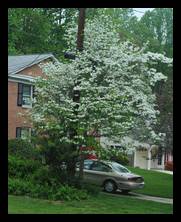
The Flowering Dogwood is a small tree that has large white flowers in the spring and bright red fruits in the fall.
Flowering Dogwood (Cornus florida syn: Benthamidia florida (L.) Spach) is a species of dogwood native to eastern North America. It ranges from Northern Florida to Southern Maine and its westward range extends to eastern Kansas and eastern Texas. Other names for it include American Dogwood and Florida Dogwood.
It is a small deciduous tree that grows 20 to 30 feet tall, generally towards the edge of the forest. It is also commonly used in landscaping.
The flowers are 2 to 3 inches wide, with four petals, each petal is one to two inches long and about 1 inch wide, with a notch at the end. The area around this indentation is redish-brown. These petals are not the true petals, they are bracts, which are a specialized type of leaf normaly associated with flowers. All the flowers on a tree are the same color, usually white, but there are variations that have pink or even red flowers (bracts). Commercial varieties usually have larger flowers than wild dogwoods.
The center of what appears to be the flower contains a cluster of the real flowers, small yellow flowers each less than a quarter inch wide. Each flower has four petals. The flowers are Monoecious and the cluster size varies from just a few to about two dozen.
Flowering occurs from early April at the southern end of its range to early May at the northern range and in high altitudes.
The berries are deep red one quarter to one half inch long, growing in a cluster of 3 to 8. The fruits are actually drupes, not berries. They ripen in the fall and are eaten by birds that spread the seeds. Squirrels will also eat the seed, leaving the fruit behind.
The leaves of a dogwood tree grow in pairs, opposite each other at the end of a twig. They are oval in shape coming to a sharp point at the end. The edge of the leave is smooth, and can be a little bit wavy. There is one center vein that runs the length of the leafe and many prominent veins that come off of it, roughly parallel to each other. These veins have even smaller veins that branch off from them. The leaves are 2.5 to 5 inches long and are a uniform green color. They are a little bit shiny. In the fall, the the leaves turn a brownish red.
The trunk of a mature tree varies in size from several inches to a foot in diameter. The bark is rough and broken, but not very thick. The branches start low to the ground. At the end of the branches are many slender twigs that the leaves grow on.
In the winter, there is a single bud at the tip of each twig. In the spring the flower and two pairs of leaves will emerge from it.
If the tree is in an open area, the crown assumes a slightly rounded shape. If the tree is shaded by other trees (such as in a forest) It will be much thinner, with branches spaced further apart.
| Habitat | |
|---|---|
| Location | Forest edge, landscaping |
| Geographic Range (North, South) | Maine to Florida |
| Geographic Range (East, West) | Atlantic Ocean to Texas, Kansas. Grows in the following states: AL, AR, CT, DC, DE, FL, GA, IL, IN, KS, KY, LA, MA, ME, MI, MO, MS, NC, NH, NJ, NY, OH, OK, PA, RI, SC, TN, TX, VA, VT, WV |
| Leaves | |
| Leaf shape | simple, oval with sharp point at the end |
| Leaf tip | pointed |
| Leaf edge | smooth, slightly wavy |
| Leaf size | 2.5 to 5 inches |
| Leaf color | solid green, shiny |
| Leaf texture | smooth |
| Leaf veins | primary vein through center of leaf, prominent secondary veins parallel to each other, smaller veins branch off secondary veins |
| Leaf grouping | pairs, opposite each other at end of twig. |
| deciduous (loses leaves in winter) | |
| Flowers | |
| Flower size | 2-3 inches in diameter |
| Flower color | white, light pink, dark pink |
| Flower grouping | single |
| Petal count | 4 |
| Petal length | 1-2 inches |
| Petal width | 1 inch |
| Petal shape | oval |
| Flowering season | April, May |
| Fruit | |
| Fruit shape | oval |
| Fruit color | shiny deep red |
| Fruit size | .25 to .5 inches |
| Fruit clusters | 3-8 |
| Fruit maturity | Fall |
| Trunk, branches, and twigs | |
| Bark | thin, rough, broken |
| Trunk diameter | several inches to a foot |
| Branches start | low to the ground |
| Crown shape | slightly rounded |